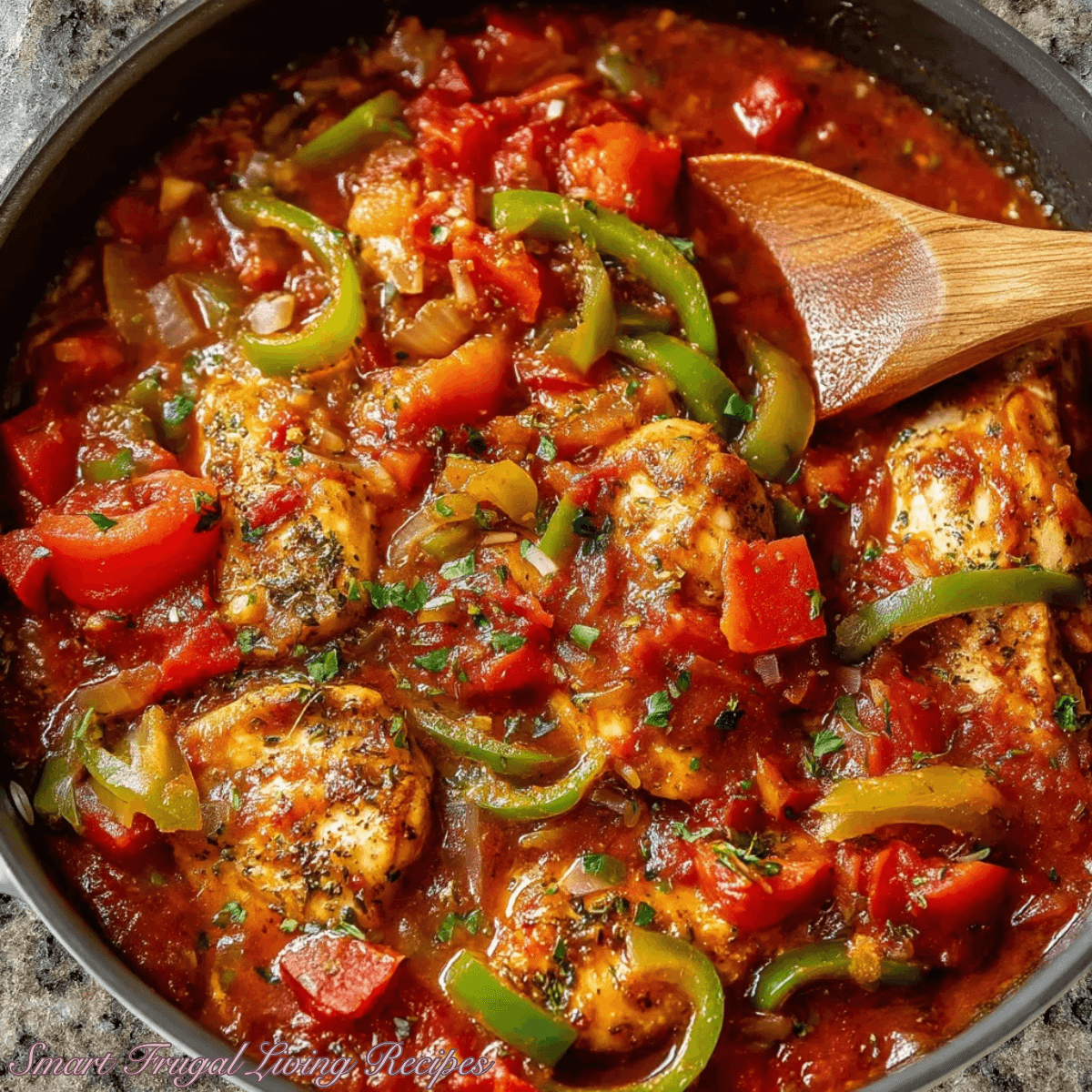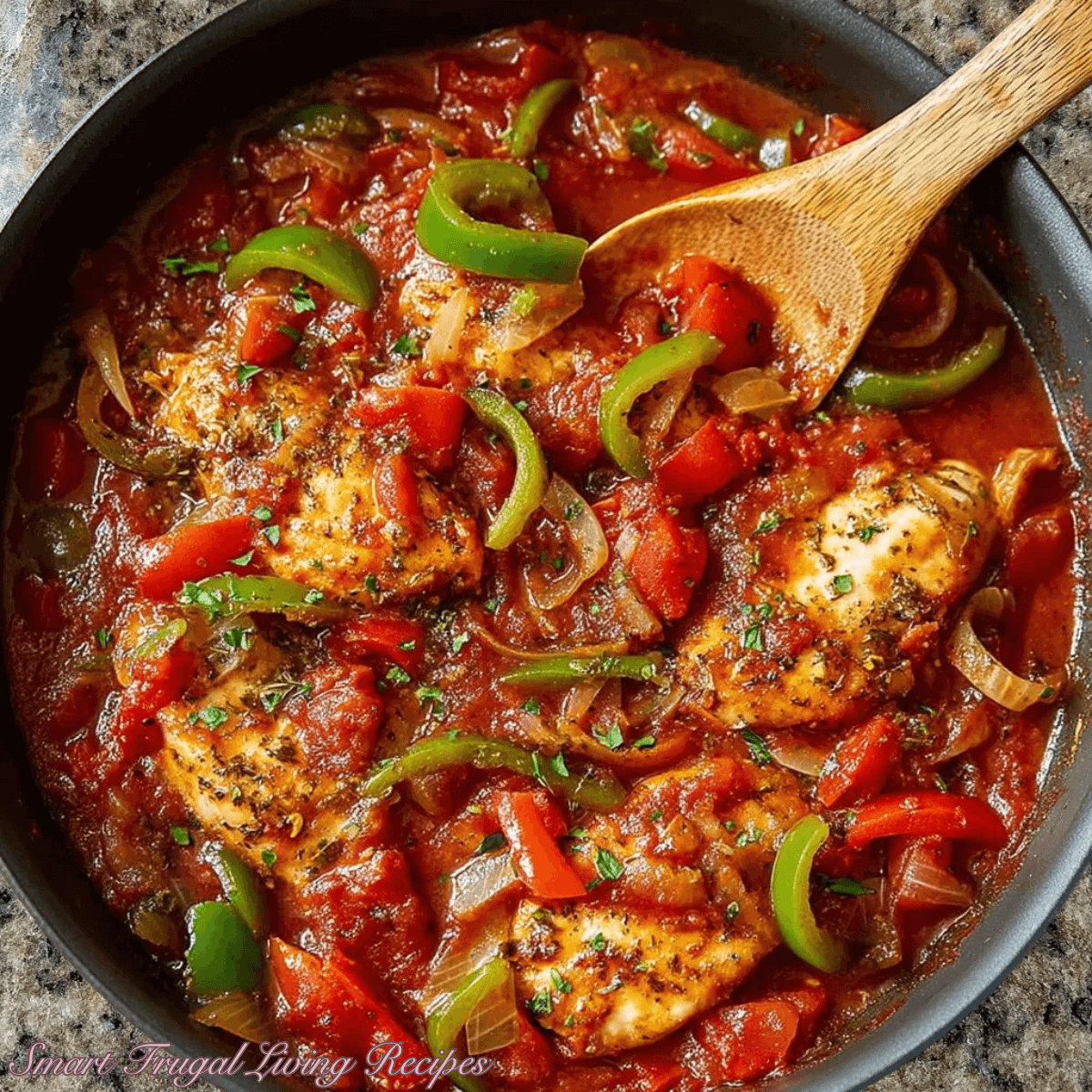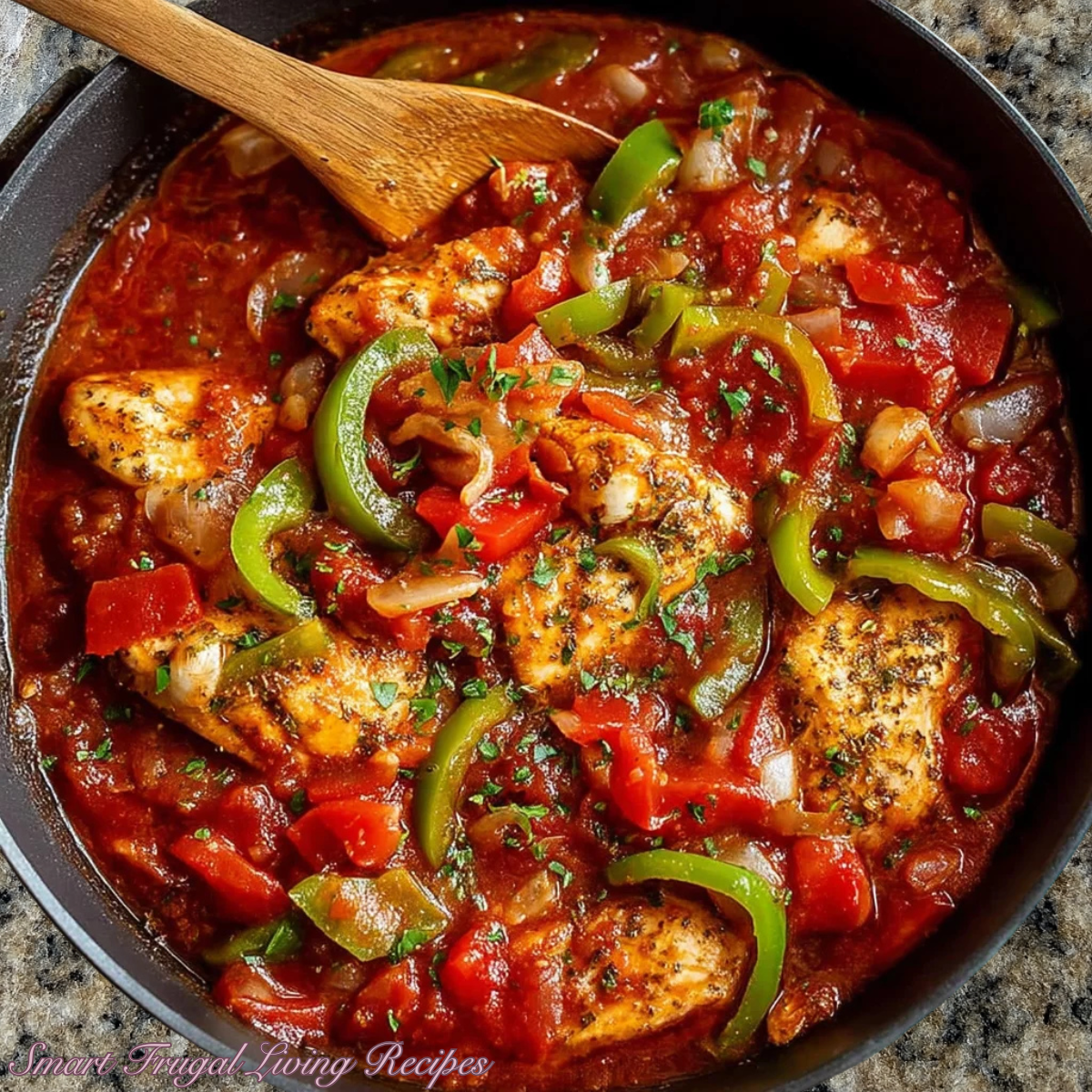Introduction
Few dishes capture the heart and soul of rustic Italian cooking quite like Chicken Cacciatore. The word cacciatore means “hunter” in Italian, and this dish, often referred to as “hunter’s chicken,” was traditionally made with whatever the hunter brought home—typically chicken or rabbit—slowly braised with tomatoes, onions, peppers, mushrooms, herbs, and sometimes wine. It’s hearty, flavorful, and deeply comforting, making it a favorite for family dinners around the world.
This recipe for Chicken Cacciatore showcases why it has remained a classic for generations. Bone-in, skin-on chicken thighs are seared until golden, then simmered in a savory sauce of crushed tomatoes, red wine, and aromatic vegetables. Mushrooms and bell peppers add depth and sweetness, while herbs like oregano, thyme, and parsley infuse the sauce with an unmistakable Mediterranean flair. The result is tender, fall-off-the-bone chicken nestled in a rich, savory sauce that begs to be spooned over pasta, creamy polenta, or crusty bread.
What I love most about Chicken Cacciatore is how flexible it is. Depending on the region of Italy (and the cook’s pantry), recipes vary widely—sometimes with white wine instead of red, olives instead of mushrooms, or even capers for tang. That means you can make it your own, adapting the flavors to suit your taste or what you have on hand.
For more Italian comfort food, you might also enjoy Osso Buco or Chicken Marsala. Both share that same soul-warming, slow-simmered appeal that makes dishes like this perfect for gathering around the table.
Let’s dive into the recipe and see why Chicken Cacciatore has stood the test of time as a beloved rustic classic.
Chicken Cacciatore Recipe

Chicken Cacciatore Recipe
Ingredients
Method
- Prep the Chicken
- Pat chicken thighs dry.
- Season both sides and under the skin with salt and pepper.
- Brown the Chicken
- Heat olive oil in a large pan or braiser over medium-high.
- Place chicken skin-side down and sear until golden brown. Flip and brown the other side (about 8 minutes total).
- Remove chicken and set aside.
- Sauté the Vegetables
- In the same pan, add onion, celery, red and green peppers, mushrooms, and garlic.
- Season with salt, pepper, oregano, thyme, parsley, and red pepper flakes.
- Cook 5–6 minutes, stirring often, until softened.
- Deglaze and Simmer
- Pour in the red wine and simmer until reduced by half.
- Stir in crushed tomatoes and cook 5–10 minutes over medium heat.
- Add Chicken and Braise
- Nestle chicken thighs into the sauce.
- Reduce heat to medium-low, cover, and simmer 30 minutes, until chicken is tender and fully cooked.
- Finish and Serve
- Garnish with fresh parsley.
- Serve warm over pasta, polenta, or with crusty bread.
Notes
- Wine choice: A medium-bodied red wine like Chianti, Merlot, or Cabernet works beautifully.
- Chicken swaps: Bone-in thighs are classic, but drumsticks or bone-in breasts also work.
- Make-ahead tip: This dish tastes even better the next day, as the flavors deepen overnight.
Advanced Techniques to Elevate Chicken Cacciatore
Choosing the Right Wine for a Deeper Sauce
The wine you choose makes a big difference. A dry red like Chianti or Pinot Noir enhances the sauce without overpowering the vegetables. For a lighter twist, swap in white wine—Sauvignon Blanc or Pinot Grigio brightens the dish and makes it feel more spring-like.
Building Flavor by Browning the Chicken Well
Take your time when searing the chicken. Golden-brown skin means caramelization, which adds depth to the sauce. Don’t overcrowd the pan; work in batches if needed. Scrape up the fond (the browned bits stuck to the pan) when deglazing with wine—that’s pure flavor.
Adding Olives or Capers for a Mediterranean Kick
Many regional versions of Chicken Cacciatore include briny ingredients like olives or capers. Adding a handful of Kalamata olives or a spoonful of capers during the simmering stage adds tangy contrast to the rich sauce.
Making a Slow-Cooker Version for Easy Prep
For a hands-off approach, brown the chicken and vegetables on the stovetop first, then transfer everything to a slow cooker. Cook on low for 6–8 hours. The flavors meld beautifully, and you’ll come home to a ready-made dinner.
Finishing with Fresh Herbs for Brightness
While dried oregano and fresh thyme build earthy depth, finishing with fresh basil or extra parsley just before serving lifts the dish with a pop of freshness. It’s a small detail that balances the richness.

Storage, Shelf Life, and Maintenance Tips
Storing Chicken Cacciatore in the Fridge
Cool leftovers completely before transferring to airtight containers. Store in the refrigerator for up to 4 days.
Freezing for Longer Storage
Chicken Cacciatore freezes well. Place cooled portions in freezer-safe containers and freeze for up to 3 months. Thaw overnight in the fridge before reheating.
Reheating Without Drying Out the Chicken
Reheat gently on the stovetop over medium-low, adding a splash of broth or water if the sauce has thickened too much. Cover while reheating to keep the chicken moist.
Preventing Mushy Vegetables in Leftovers
If you plan to freeze, consider slightly undercooking the peppers and mushrooms. They’ll soften further when reheated, giving you better texture later.
Using Leftovers Creatively
Shred leftover chicken and stir into pasta, risotto, or grain bowls. The sauce also makes a delicious base for baked eggs (similar to shakshuka).

Dietary Adaptations and Substitutions
Making a Lighter, Skinless Version
For a lower-fat option, remove the chicken skin before cooking. You’ll sacrifice a little richness, but the dish will still be flavorful and satisfying.
Gluten-Free Chicken Cacciatore
This recipe is naturally gluten-free, but double-check labels on canned tomatoes and spices. Serve with gluten-free pasta, polenta, or rice.
Dairy-Free Friendly
Chicken Cacciatore is already dairy-free, making it perfect for those avoiding lactose. If serving with polenta, use olive oil instead of butter for a fully dairy-free meal.
Low-Sodium Adaptation
Skip added salt in the vegetables and use low-sodium canned tomatoes. The herbs and garlic will keep the flavor vibrant without the extra sodium.
Vegetarian “Cacciatore” with Chickpeas
For a plant-based spin, replace chicken with two cans of chickpeas or sautéed eggplant and zucchini. The sauce alone is so flavorful, it works beautifully with vegetarian ingredients.

FAQs About Chicken Cacciatore
Can I Use Boneless Chicken Instead of Bone-In?
Yes, boneless chicken thighs or breasts can be used. Reduce the simmering time to 20–25 minutes, as they cook faster.
Do I Have to Use Wine in the Sauce?
No, you can substitute chicken broth for wine. The flavor will be lighter, but still delicious. A splash of balsamic vinegar adds complexity if you skip wine.
What’s the Best Side Dish for Chicken Cacciatore?
It pairs beautifully with pasta, creamy polenta, mashed potatoes, or a simple crusty bread for soaking up the sauce.
Can I Make This Dish Ahead of Time?
Absolutely. In fact, it tastes even better the next day as the flavors meld. Store in the fridge overnight and reheat before serving.
Why Is My Sauce Too Thin?
If the sauce is too watery, remove the chicken once cooked and simmer the sauce uncovered for 10 minutes to thicken before returning the chicken to the pan.

Conclusion & Final Thoughts
Chicken Cacciatore is a dish that celebrates everything we love about rustic Italian cooking—simple ingredients, slow simmering, and bold, comforting flavors. With juicy chicken thighs, sweet peppers, earthy mushrooms, and a tomato-wine sauce, it’s the kind of meal that fills your kitchen with irresistible aromas and your table with happy faces.
I love how versatile it is—whether you stick to the traditional version or add your own twists with olives, capers, or fresh herbs, it always delivers a cozy, satisfying result. It’s also make-ahead friendly and freezer-friendly, which makes it as practical as it is delicious.
If you’ve been searching for a hearty dish that feels both rustic and refined, Chicken Cacciatore is it. Serve it with pasta, polenta, or warm bread, and you’ve got a meal that feels like it came straight from a countryside kitchen in Italy. One bite and you’ll understand why this recipe has been loved for generations—and why it will likely become a staple in your own home too.



